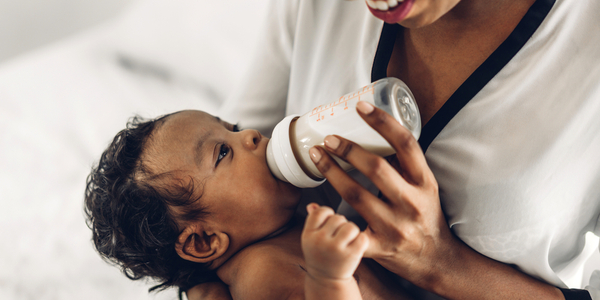Dream feed

Have you tried everything to get your baby to sleep longer at night? If the sleep deprivation is all too much, then we've got something that might interest you. That's right, it's called dream feeding.
If you've heard all about dream feeds but aren't too sure about what it is or how to do it then don't worry. In this post i've listed all my hints and tips about dream feeding your baby and how you can incorporate it as part of your night feedings effectively!
What is a dream feed?
A dream feed is a feed that you give a baby when they have already gone to sleep for the night. I recommend that this feed is offered at approx. 10.30 pm – just before you settle to bed yourself!
Research shows that sneaking in an extra feed between 10 p.m. and midnight usually reduces night wakings, helping babies sleep longer stretches throughout the night.
The great thing about a dream feed is that it can become a regular part of your baby's sleep schedule.
Many parents are reluctant to try it as they're worried they will wake their sleeping baby but you won't know until you try it! Most babies stay asleep through a dream feed but others may wake a little and this is completely normal.

Why should you use a dream feed?
The dream feed is all about making sure that your baby has a full tummy before entering their core phase of sleep during the night.
This should help them to sleep longer as waking for hunger will have been minimised thanks to this additional sleep feeding.
Your baby should fall asleep straight away after a dream feed and more uninterrupted sleep should result.
When to start dream feeding your baby
Newborn babies only have small stomachs, meaning they need to eat more frequently - at least every two to four hours.
Once your baby has started to show signs that they can sleep for longer stretches at night (around 3 months' old) without waking for a feed, then you can give a dream feed a try!
You can implement dream feeding with an older baby, but around the age of 4-6 months' old, most babies sleep around 10-12 hours per night and don't require many feeds anymore, so a nighttime feed may not even be necessary at that point.
I recommend that you only dream feed up to the age of 6 months' - any longer than this and you are at risk of recurrent night wakings due to sleep associations.
How to dream feed your baby
Dream feeding your baby is fairly easy. Here’s how it works:
Gently wake the baby
After your baby has been sleeping for a couple of hours, you will want to wake them up. You don't want them to fully wake, you just need them to be awake enough to take a full feed.
Top tips:
- Ensure the room is kept dark
- Don't talk or make eye contact
- Avoid changing your little one's nappy, only do this if really necessary
- Gently pick up the baby from their crib to avoid waking them fully

Get ready to feed your baby
How long and how much you should feed your baby varies. Breastfed babies may need to nurse for 15 minutes per side whereas bottle-fed babies could need anything between 4-6oz.
Unfortunately, there is no one size fits all. It all depends on their age, weight, and how recently your baby last fed.
Put your baby back to sleep
Once you have fed your baby, the goal is to put your little one back to sleep without waking them. This can be difficult, but I promise you that it can be done - it just takes a few tries first!
The key here is to avoid using fast movements. Instead, just like how you woke them up, you should use slow and steady movements so that you don't startle your baby.
Lay them back to sleep under a blanket or in their sleepsuit on their back in their sleep space.
Before laying your little one back down to sleep, you need to ensure that you have burped them so that you can avoid any reflux or stomach discomfort.
Gently prop your little one over your shoulder and rub their back to get gas out of them.
Tips for dream feeding your baby

Dream feed when your baby is in an active sleep period
We all have sleep cycles. In fact, they change and develop as we grow and newborn babies sleep in short cycles, around 20-50 minutes long.
Sleep cycles consist of active and quiet sleep. When your baby is in the active sleep phase (also known as Rapid Eye Movement sleep) they may move, make noises, breathe noisily or flutter their eyelids. During quiet sleep, they will be still and their breathing will be more regular.
If you can, try and catch your baby at a time when they are in the active sleep phase as they are more likely to suckle and get a better dream feed.
Time it to maximise sleep
You should aim to feed your baby at least three hours after they last ate, any sooner and your baby may be too full to take any more milk and make the dream feed effective.
Depending on your baby's sleep schedule, this may mean you dream feed them between 10-11 pm.
Dream feed before you go to bed for the night
Most parents opt for a dream feed just before they go to bed for the night. Around 10-11 pm is good for most young babies as it will allow them to be full enough to sleep until the early morning hours.
Gently wake your baby up
If you struggle to wake your baby up, slowly take them out of their swaddle or sleeping bag. If this still doesn't work consider popping a leg out of their sleepsuit or changing their diaper as this can help to gently wake them enough to take a dream feed.
Put your breast or bottle near your baby's mouth
If your baby is in the REM sleep phase put your breast or bottle near their mouth. This should help stimulate their rooting reflex allowing them to easily latch on for a bedtime feeding.
Remember to hold your baby upright when feeding.
Follow safe sleeping guidelines
Once your baby's tummy is nice and full and they have stopped taking milk, burp them to relieve potential gas before popping them back in their crib flat on their back.

Benefits of dream feeding
Benefits for baby
In the newborn stage, babies need to eat every 2-3 hours, including at night. Unlike many sleep training methods that encourage babies to sleep through the night without a feed, dream feeding allows you to feed your baby without interfering with their nighttime sleep allowing you both to sleep longer stretches at night.
Benefits for parents
While the sleep deprivation is all too real with a newborn baby, it can actually wreak havoc on your physical and mental health.
Lack of sleep changes your hormonal balance and metabolism and decreases the function of your immune system making you more prone to infections and mental health disorders such as depression, stress, and anxiety.
Dream feeding works by topping up your baby's tummy with enough milk so that they can sleep a longer stretch and therefore allowing you to catch up on some precious zzzs yourself!
Does a dream feed work?
Sometimes yes, sometimes no.
In my experience, though it is more likely to be successful and supportive of a longer spell of sleep for your baby. Whether it will work for you will be down to giving it a try for at least 10 days and seeing how your baby responds.
There are schools of thought out there that using it can actually disrupt your children's sleep patterns however this is something that I have not found with the countless families I have worked with – plus my own 3 children.
So you are going to give it a try?
If you do decide to dream feed your baby, there are a few things you need to do;
- I recommend that the dream feed take place at about 10.30 pm to coincide with when you are heading to bed yourself.
- I recommend that the dream feed be a bottle feed. If you are a breastfeeding mum, offering this as an expressed bottle or formula bottle will allow you to go to bed a little earlier – you need your extra rest – and allow your partner to offer this feed to your baby. This can be a lovely bonding time for your partner and one I know my husband enjoyed with our children.
- Enter their room while keeping it nice and dark. Use the light from the hall or landing only. Keep everything nice and calm and interaction to a minimum.
- I recommend very gently changing your baby’s nappy before you start the feed. This will wake them enough that they will take the feed easily but also ensure you minimise the risk of a leaky nappy later on in the night.
- Keep them in their sleeping bag while feeding – this will allow you to simply give them the feed and return them to their cot.
- It is less likely that they will be windy during this feed as they will be so relaxed taking it. I do however recommend sitting your baby up on your knee for a period of time – say 3 to 5 minutes to see if they get some wind-up.

Is it too late to start using a dream feed?
I recommend that the dream feed be used as early as possible – as soon as you come home from the hospital really. However, if you are beyond 4 months and your baby is not sleeping through the night and you would like to see if the dream feed would help then go for it!
It is absolutely worth trying if your baby is not sleeping through the night. Remember that you will not see change overnight, it could take up to 10 days to see positive change from the introduction of the dream feed to come. So, pick a night, offer it and stick with it! As your baby gets older and is introduced to solid feed you can start to work on fading the dream feed out as long as they are having settled nights.
If your baby is 9 months plus, however, well established on solids and not sleeping through a dream feed may not be the answer.
You may need to take a look at bedtime routines and daytime napping schedules to see how improvements can be made that will help promote a restful night's sleep for everyone.
I’ve tried it, but it's not working!
So you’ve tried it and used it for the 10 days I’ve recommended and have followed my guidelines above – but it isn’t working. Then, I’m afraid I would take a look at the parameters around your little one's sleep.
If your baby is beyond 6 months, you are using a dream feed, and they are more than once at night then something else could be contributing to that. It could be that their daytime napping structure needs to be tweaked or perhaps their soothing skills need some work. Overall, the dream feed is not going to be the answer when the wakes at night are not due to hunger!
So, what should you do? Dream feed or not!
Ultimately I would say give it a go! It won’t do any harm trying it out for the 10 days time frame that I suggested and if it doesn’t work you can always stop. I have found however that when the dream feed is used in conjunction with a structured feeding schedule during the day parents can see positive results.
Work on establishing supportive sleep habits for your child and the cab dream feed will lead you on the way to The Gift of Sleep.

